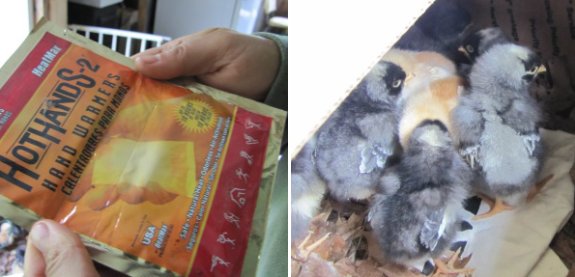
Disposable hand warmer=emergency chick warmer

We lost power this morning
and the new chicks started complaining loudly.
One of the portable
power packs came in handy
to keep the incubator warm, but the other pack didn't have enough juice
to run the brooder. Ooops! I should have topped off that charge last
week when I tried jumping the car.
Anna had the great idea to
use a disposbale hand warmer, and it only took me 10 minutes to dig
through a box of stuff to find it. It felt a bit too hot, so we wrapped
it in a small piece of cloth. 10 minutes later the peeping shifted from
"we're too cold!" to "things are fine here".
The package claims you can
get 10 hours of heat from these things. Our power came back in about 2
hours and now we've decided to make a point to have a few of these on
hand for any future emergency chick warming.
Want more in-depth information? Browse through our books.
Or explore more posts by date or by subject.
About us: Anna Hess and Mark Hamilton spent over a decade living self-sufficiently in the mountains of Virginia before moving north to start over from scratch in the foothills of Ohio. They've experimented with permaculture, no-till gardening, trailersteading, home-based microbusinesses and much more, writing about their adventures in both blogs and books.
Want to be notified when new comments are posted on this page? Click on the RSS button after you add a comment to subscribe to the comment feed, or simply check the box beside "email replies to me" while writing your comment.

Here you go.
The MRE heater that gives of hydrogen sounds like the an oxidation reaction with water. It is actually interesting chemistry.
I was hoping you would chime in! I'm having a bit of trouble guessing, from that page, what our hand warmer would be. I'm guessing it would be the air activated iron since it's disposable? Since the iron is being oxidized, I assume there's no off-gassing?
I was intrigued by the old-fashioned kind mentioned further down:
One of the older and perhaps less used types of handwarmer are made hot through the burning of charcoal in a special case. These can last up to 6 hours and become comfortably hot. The cases for these usually have felt on the outside and have materials inside that do not burn, but spread the heat evenly such as metal. To activate, one or both ends of a stick of charcoal are lit and then quickly extinguished to create a hot ember. The smoldering stick is then placed inside the case and the case is tightly shut. The charcoal sticks are available from most outdoor activity shops and are fairly inexpensive.
Sounds like that's what we should have!
There will be no outgassing from the activated iron, but it will use oxygen. So it might not not suitable for an enclosed space (depending on size).
The charcoal and light fluid heaters will also use oxygen and additionally give off CO2 or even CO if the fire is starved of oxygen. So these are definitely not suited for enclosed space or even for an open topped box, since CO and CO2 can accumulate at the bottom.
I think the old-fashoineded water bottle is one of the best ways to go. The heat capacity of water is very high.
I was going to ask what you thought of the heat capacity of water vs. rock, but then saw that building materials were in a second chart further down. I didn't realize water was more than four times as good thermal mass as brick or most stones!
I didn't realize water was more than four times as good thermal mass as brick or most stones!
I don't understand why wood is so high, though. Maybe I'm misunderstanding --- I think of heat capacity as the ability of a substance to soak up warmth from another heat source (like the sun or a fire) and then hold onto it for a while as it slowly radiates the heat back out into the room. But wood doesn't seem to hold onto heat? Maybe its high heat capacity is counteracted by the fact that wood is so light in comparison to the other materials, so even though it can hold a certain number of Joules per gram, there are just a lot fewer grams in a hunk of wood than in a similarly sized bottle of water?